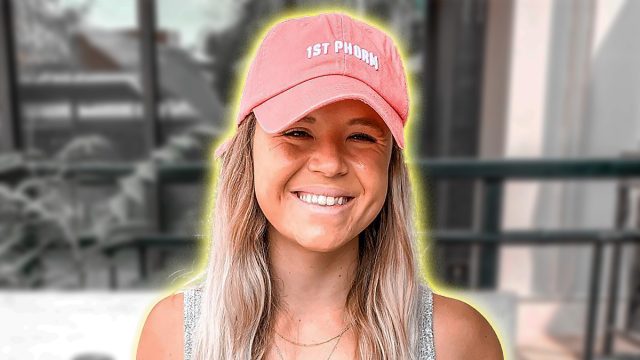4 Daily Habits This Weight Loss Coach Uses to Make Clients "Unrecognizable"
Do you want to transform your body by summer? According to one expert, it may be as simple as adopting four healthy habits. Hannah Hammes is a weight loss coach who creates "quick and effective" workouts for busy women. In a recent social media post, she reveals "4 habits" to "become addicted to" if you want to "become unrecognizable," she writes. "You're willing to do the work to become unrecognizable, right? Maybe you've 'tried it all,' but ever since you've had babies, you're just not seeing the results you want to see. Is your metabolism broken?! Are your hormones to blame?" She goes on to reveal the four habits "to become addicted to over the next 6 months."
Amp Up Your Protein Intake
"Eat at least 30g of protein at every meal," she writes in the post. "Now, I know you think that's too much food, but I promise if you want to get there, you need to eat your protein. And heck, "eat less, move more" hasn't gotten you the results you're looking for anyway, so what do you have to lose +." (Keep reading for high-protein breakfast ideas!)
Start Strength Training
She also suggests doing 30-minute strength training workouts "right at home" for convenience. "Why?? Because these will fit in your day more easily. You can wake up 30 min earlier or do it while your kiddos play nearby. The more consistently your plan allows you to be, the quicker you will see results," she says. "Get in at least three a week. If you can't do that, at least commit to 8k daily steps to start out."
RELATED: 10 Steps This Fat Loss Coach Used to Drop 20 Pounds Without Gaining It Back
Get Your Rest
Sleep is another key health habit if you want to lose weight. "Get at least 6-7hrs of sleep every night (so go to sleep instead of staying up all night scrolling 00)," she says. What are the health benefits of sleep? According to the Sleep Foundation, getting enough z's is a mood booster, promotes heart health, regulates blood sugar, improves mental function, restores your immune system, helps relieve stress, and aids in weight loss.
Hydrate
Her final transformation habit? Hydrate. "Drink your water sis!" she suggests. "At a minimum half your body weight in oz of water. 80+ oz is good! And add electrolytes!" According to the Mayo Clinic, hydration is important for a variety of reasons. Water helps get rid of waste through urination, perspiration, and bowel movements, keeps your temperature normal, lubricates and cushions joints, and helps protect sensitive tissues.
High Protein Breakfast 1: Cottage Cheese Eggs
In another post she reveals 5 breakfasts she eats "on repeat" when she wants "to drop body fat" fast. "All under 15 minutes, 30-50 grams protein, under 500 calories." The first breakfast is cottage cheese eggs: "2 eggs + 1/2 cup liquid egg whites whisked together. Cook in a pan & when almost cooked through, add 1/2 cup cottage cheese and continue mixing in the pan! Add fruit of choice," she instructs in the post. Calories: 298, Protein: 38g.
RELATED: 8 Doctor-Approved Ways to Lose Weight "Without Counting Every Calorie"
High Protein Breakfast 2: Egg Sammy
She also loves this Egg Sammy: "1 English muffin toasted, 1 egg + ½ cup liquid egg whites scrambled & cooked together, 2 slices Canadian bacon & 2 tbsp reduced fat cheddar. Add all ingredients to your English muffin & enjoy!" she says. Calories: 352, Protein: 34g.
High Protein Breakfast 3: Protein Pancakes
Protein pancakes are another protein-packed, delicious morning meal. "1 serving Kodiak cakes flavor of choice, 1 scoop protein powder, 1/3 cup fairlife reduced fat milk. Mix all together and cook as pancakes!" she says. Calories: 380, Protein 41g.
High Protein Breakfast 4: Breakfast Burrito
And, who doesn't love breakfast burritos? "1 low carb tortilla, 2 tbsp reduced fat shredded cheddar, 1 egg + 1/2 cup liquid egg whites scrambled & cooked together, 2 turkey sausage links, diced, 2 tbsp salsa. Add all ingredients to your tortilla form your burrito!" she says. Calories: 330 Protein: 35g.
RELATED: 10 Food Ingredients This Coach Avoids at All Costs
High Protein Breakfast 5: Smoothie
Smoothies are an easy way to get your protein fix. "1 cup reduced fat fairlife milk, 1 scoop protein powder, 1/2 cup Greek yogurt, 1 cup frozen berries, 1/2 cup frozen cauliflower. Blend all ingredients together & enjoy!" she says. Calories: 377, Protein: 47g. And if you enjoyed this article, take advantage of these 15 Quick Ways to Lose Body Fat Percentage in a Week.





